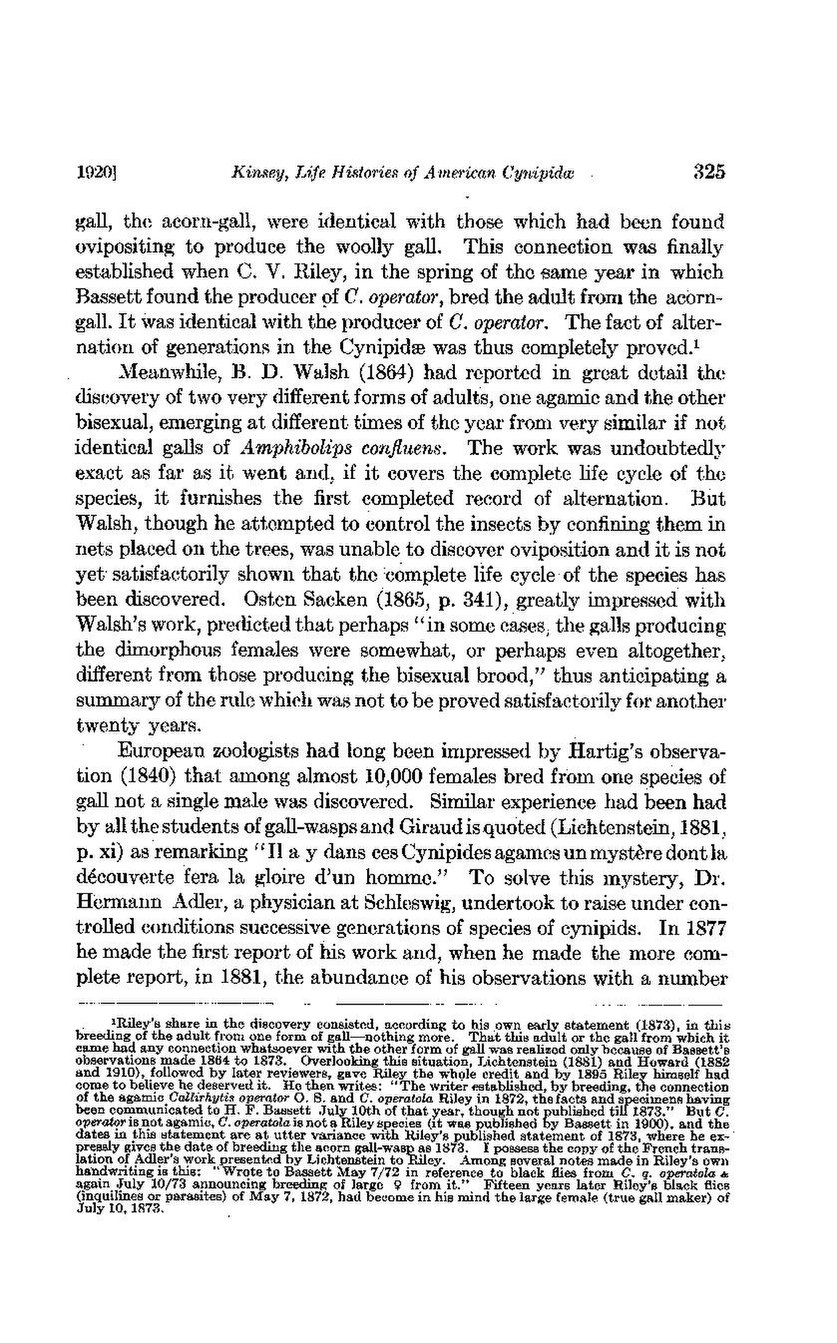gall, the acorn-gall, were identical with those which had been found ovipositing to produce the woolly gall. This connection was finally established when C. V. Riley, in the spring of the same year in which Bassett found the producer of C. operator, bred the adult from the acorn-gall. It was identical with the producer of C. operator. The fact of alternation of generations in the Cynipidæ was thus completely proved.[1]
Meanwhile, B. D. Walsh (1864) had reported in great detail the discovery of two very different forms of adults, one agamic and the other bisexual, emerging at different times of the year from very similar if not identical galls of Amphibolips confluens. The work was undoubtedly exact as far as it went and, if it covers the complete life cycle of the species, it furnishes the first completed record of alternation. But Walsh, though he attempted to control the insects by confining them in nets placed on the trees, was unable to discover oviposition and it is not yet satisfactorily shown that the complete life cycle of the species has been discovered. Osten Sacken (1865, p. 341), greatly impressed with Walsh's work, predicted that perhaps "in some cases, the galls producing the dimorphous females were somewhat, or perhaps even altogether, different from those producing the bisexual brood," thus anticipating a summary of the rule which was not to be proved satisfactorily for another twenty years.
European zoologists had long been impressed by Hartig's observation (1840) that among almost 10,000 females bred from one species of gall not a single male was discovered. Similar experience had been had by all the students of gall-wasps and Giraud is quoted (Lichtenstein, 1881, p. xi) as remarking "Il a y dans ces Cynipides agames un mystère dont la découverte fera la gloire d'un homme." To solve this mystery, Dr. Hermann Adler, a physician at Schleswig, undertook to raise under controlled conditions successive generations of species of cynipids. In 1877 he made the first report of his work and, when he made the more complete report, in 1881, the abundance of his observations with a number
- ↑ Riley's share in the discovery consisted, according to his own early statement (1873), in this breeding of the adult from one form of gall-nothing more. That this adult or the gall from which it came had any connection whatsoever with the other form of gall was realized only because of Bassett's observations made 1864 to 1873. Overlooking this situation, Lichtenstein (1881) and Howard (1882 and 1910), followed by later reviewers, gave Riley the whole credit and by 1895 Riley himself had come to believe he deserved it. He then writes: "The writer established, by breeding, the connection of the agamic Callirhytis operator O. S. and C. operatola Riley in 1872, the facts and specimens having been communicated to H. F. Bassett July 10th of that year, though not published till 1873." But C. operator is not agamic, C. operatola is not a Riley species (it was published by Bassett in 1900), and the dates in this statement are at utter variance with Riley's published statement of 1873, where he expressly gives the date of breeding the acorn gall-wasp as 1873. I possess the copy of the French translation of Adler's work presented by Lichtenstein to Riley. Among several notes made in Riley's own handwriting is this: "Wrote to Bassett May 7/72 in reference to black flies from C. q. operatola & again July 10/73 announcing breeding of large ♀ from it." Fifteen years later Riley's black flies (inquilines or parasites) of May 7, 1872, had become in his mind the large female (true gall maker) of July 10, 1873.
